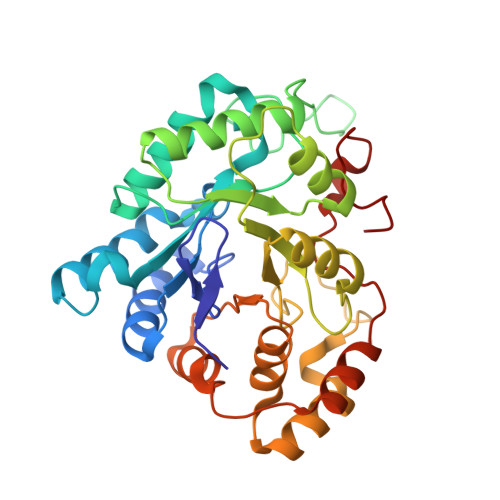Efficacy of aldose reductase inhibitors is affected by oxidative stress induced under X-ray irradiation.
Castellvi, A., Crespo, I., Crosas, E., Camara-Artigas, A., Gavira, J.A., Aranda, M.A.G., Pares, X., Farres, J., Juanhuix, J.(2019) Sci Rep 9: 3177-3177
- PubMed: 30816220
- DOI: https://doi.org/10.1038/s41598-019-39722-0
- Primary Citation of Related Structures:
6F7R, 6F81, 6F82, 6F84, 6F8O - PubMed Abstract:
Human aldose reductase (hAR, AKR1B1) has been explored as drug target since the 1980s for its implication in diabetic complications. An activated form of hAR was found in cells from diabetic patients, showing a reduced sensitivity to inhibitors in clinical trials, which may prevent its pharmacological use. Here we report the conversion of native hAR to its activated form by X-ray irradiation simulating oxidative stress conditions. Upon irradiation, the enzyme activity increases moderately and the potency of several hAR inhibitors decay before global protein radiation damage appears. The catalytic behavior of activated hAR is also reproduced as the K M increases dramatically while the k cat is not much affected. Consistently, the catalytic tetrad is not showing any modification. The only catalytically-relevant structural difference observed is the conversion of residue Cys298 to serine and alanine. A mechanism involving electron capture is suggested for the hAR activation. We propose that hAR inhibitors should not be designed against the native protein but against the activated form as obtained from X-ray irradiation. Furthermore, since the reactive species produced under irradiation conditions are the same as those produced under oxidative stress, the described irradiation method can be applied to other relevant proteins under oxidative stress environments.
- Alba Synchrotron, carrer de la Llum 2-26, 08290 Cerdanyola del Vallès, Barcelona, Catalonia, Spain.
Organizational Affiliation:


















